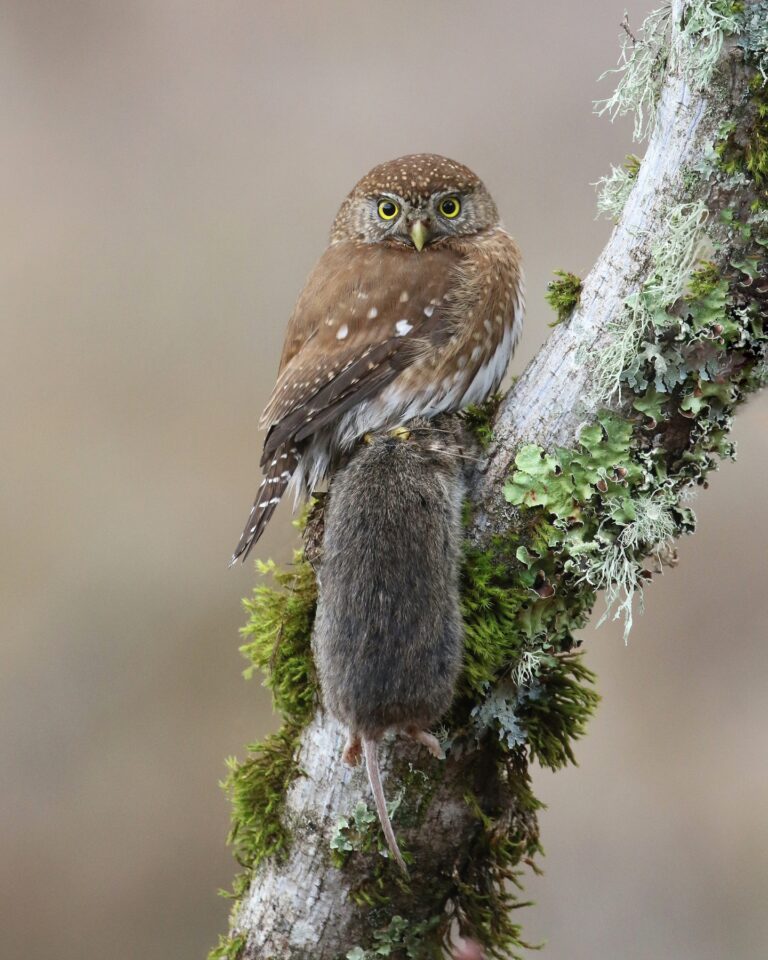Robin Agarwal’s passion for photography began in the 1990s, traveling the world as a freelance business journalist. “My roots are in California,” she says, “and like this owl, whose coloration and habits reflect its forest environment, I hope my photography reflects something of the place it comes from.”
The Northern Pygmy-Owl in her winning image is one of the smallest species of owl in North America. “In flight, they’re like wrens, very tiny and very fast,” she explains. “If you make a fist, that’s the size.”
They’re also extraordinarily patient diurnal hunters who drop down on lizards and small birds as well as their mainly rodent prey. “It’s amazing it could fly with something that big in comparison to its body,” Agarwal observes. Voles weigh about 70 percent as much as a Northern Pygmy-Owl.
Her carefully composed, razor-sharp image of the bird with the camouflage plumage and piercing yellow eyes was captured in a Santa Clara County park on the San Francisco Peninsula on the traditional territory of the Ohlone.
“The day before, a friend let me know where it had been spotted,” says Agarwal. “I was involved in a newt roadkill survey — thousands of newts a year are massacred on one Santa Clara County road, and we do a lot of documentation — but the next morning it didn’t take me too long to find the owl. This was early morning, drizzly and cold. After sitting still in an oak tree for a very long time, the owl dove down probably 10 feet from our feet and killed the vole. There were three of us, and we all froze as it lifted the vole into the air and flew to the lichen-covered branch where this photo was taken. This is one of only a few frames where it even bothered to look at us during its breakfast.”
Agarwal captured her image with a 100-400 mm lens. “It’s the only lens I have,” she says. “The same one I use for whales. I also do a lot of native bee photography, so I’m using this same versatile telephoto lens as a macro lens.
“I’ve been doing bird photography just under 10 years, and this is the first Northern Pygmy-Owl I’ve seen.”
“The reason I was able to get a good photo was that I was at a good distance,” she continues. “It’s important to have respect for the bird and allow it to behave naturally. Birds tell us when we need to back up, when we disrupt their behavior.”
And closer isn’t always better. “I’ve been doing bird photography just under 10 years, and this is the first Northern Pygmy-Owl I’ve seen,” says Agarwal. “I want to show more of the location in my photos. When you take a picture of something, the photo is improved if you show the environment a bit. Including more of the surrounding environment helps describe the subject’s relationship to a place and, by extension, demonstrates the need for public lands and public access.”
Canon EOS 7D Mark II with EF 100-400 mm lens at f/4.5-5.6, fully extended. ISO 2000, 1/400 second
Look for more of Robin Agarwal’s photos on Flickr here.
Winner in the California Watchable Wildlife 2021 10th annual California Wildlife Photo of the Year for Publication Period Jan – Feb 2021.



